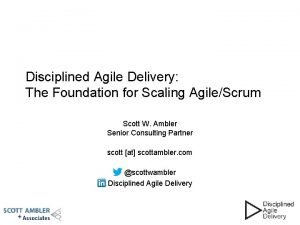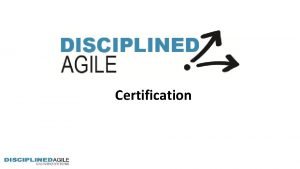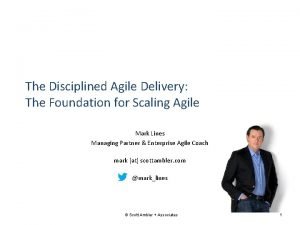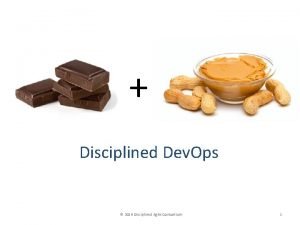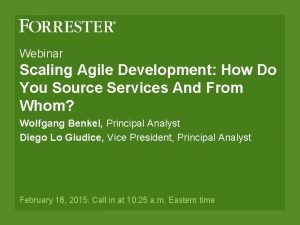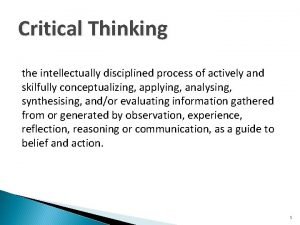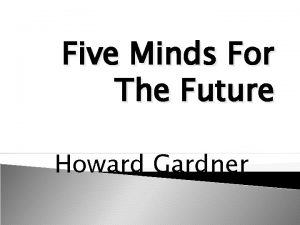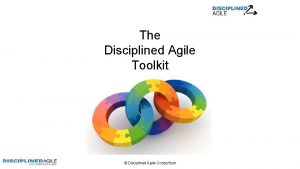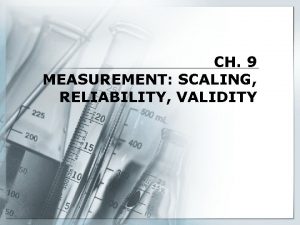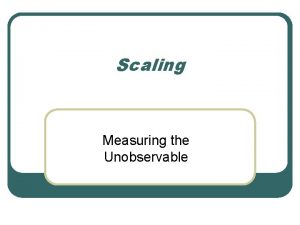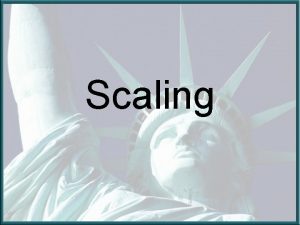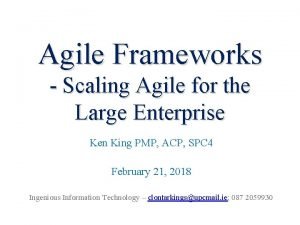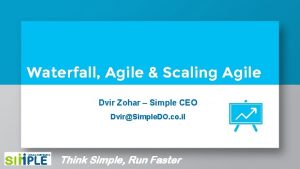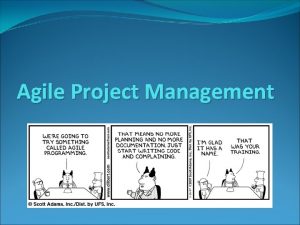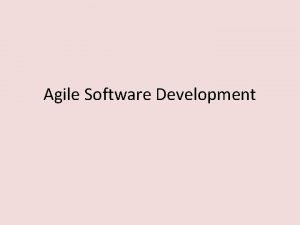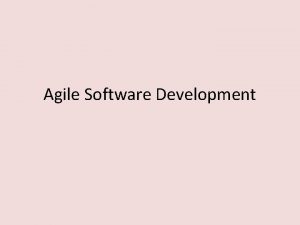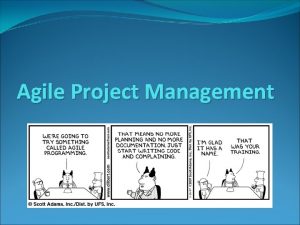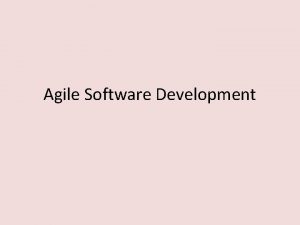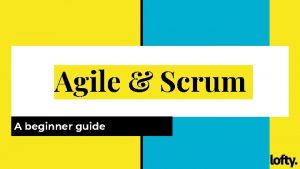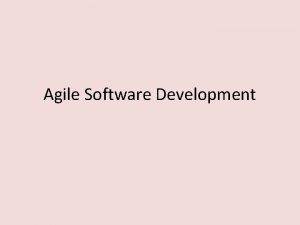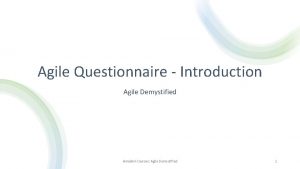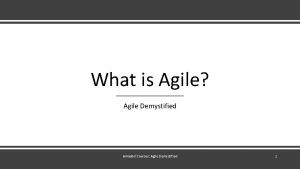The Disciplined Agile Delivery The Foundation for Scaling















































![Thank you! • Scott Ambler + Associates – www. scottambler. com – Mark [at] Thank you! • Scott Ambler + Associates – www. scottambler. com – Mark [at]](https://slidetodoc.com/presentation_image_h/1b278c1a0e058c7b1708f4aab2982299/image-48.jpg)



















- Slides: 67

The Disciplined Agile Delivery: The Foundation for Scaling Agile Mark Lines Managing Partner & Enterprise Agile Coach mark [at] scottambler. com @mark_lines © Scott Ambler + Associates 1

We’re going to cover a lot of ground © Scott Ambler + Associates 2

• An agile enterprise is able to anticipate and respond swiftly to changes in the marketplace. Agile Enterprise • It does this through an organizational culture and structure that facilitates change within the context of the situation that it faces. • Agile enterprises require a learning mindset in the mainstream business and underlying lean and agile processes to drive innovation. © Scott Ambler + Associates 3

• An Agile IT organization must be responsive to the needs of the rest of the enterprise while “keeping the lights on”. Agile IT • An Agile IT organization does this via three ongoing efforts: – Plan – Build – Run Agile Enterprise © Scott Ambler + Associates 4

• Disciplined agile delivery teams produce consumable solutions often and early • Agile delivery teams must tailor their approach to address the situation that the find themselves in, particularly when working at scale – Context counts Agile Dev Agile IT Agile Enterprise © Scott Ambler + Associates 5

Let’s explore several important questions…. What is an agile enterprise? What does agile IT look like? How does agile delivery work in enterprises? How do you transition to enterprise agility? © Scott Ambler + Associates 6

The Agile Enterprise © Scott Ambler + Associates 7

Agile/Scrum is a Good Starting Point • • • Construction focus Value driven lifecycle Self-organizing teams Prescriptive Project team aware © Disciplined Agile Consortium 8

DAD Solidifies the Foundation • Delivery focus • Risk-value driven lifecycle • Self-organization with appropriate governance • Goal driven • Enterprise aware © Disciplined Agile Consortium 9

Agility at Scale • Large teams • Geographically distributed teams • Compliance • Domain or technical complexity • Cultural issues • Organizational distribution © Disciplined Agile Consortium 10

Individuals Are Agile Individuals must become a truly agile practitioner within the evolving context of the situation that they face They will require training, education and coaching © Disciplined Agile Consortium 11

Teams Build Solutions Teams will self organize their work strategy, their structure, and their collaboration paths to reflect the context of the situation that they find themselves in They will require guidance to do so effectively © Disciplined Agile Consortium 12

IT Departments Become Agile IT departments are often sophisticated entities with teams addressing a wide range of situations and a wide range of goals Agile delivery teams are just part of the overall mix, as are operations teams, architecture teams, portfolio management teams, and many more IT organizations will need to adopt a wide range of strategies that reflect the challenges that they face © Disciplined Agile Consortium 13

The Agile Enterprise An agile enterprise has two key characteristics*: • Response ability – The physical ability to act is derived from two sources, an organizational structure that enables change and an organizational culture that facilitates change • Knowledge management – The intellectual ability to find appropriate things to act on and encompasses both top-down knowledge portfolio management (KPM) and bottomup collaborative learning * Response Ability by Rick Dove, 2001. © Disciplined Agile Consortium 14

The Agile IT Department © Scott Ambler + Associates 15

Organizing an IT Department Guide the organization in IT-related manners Teams provide consumable solutions on a regular basis in a context-driven manner Operate and support the IT ecosystem © Scott Ambler + Associates 16

Where the IT Budget Typically Goes 5 -10% 15 -25% 65 -80% © Scott Ambler + Associates 17

Where We’d Like the IT Budget to go 5 -10% 35 -50% 40 -50% © Scott Ambler + Associates 18

People Management Portfolio Management Guiding the organization in IT-related manners Program Management Enterprise Architecture Reuse Engineering © Scott Ambler + Associates 19

Continuous Delivery Exploratory/Lean Startup Providing consumable solutions on a regular basis in a context-driven manner Lean/Kanban Agile/Scrum Other Lifecycles Release Management © Scott Ambler + Associates 20

Operations Operating and supporting the IT ecosystem Support Continuous Improvement Governance © Scott Ambler + Associates 21

What Does Dev. Ops Mean to Your Organization? Continuous delivery? + streamlined operations and support? Streamlined build (dev) + streamlined run (ops)? Your Dev. Ops strategy will reflect your organizational goals © Scott Ambler + Associates 22

What Does “Agile at Scale” Mean to Your Organization? Large-scale Scrum? + Build for large agile/lean teams? Agile for the IT department? There is no one right answer for how to scale agile to the IT level. © Scott Ambler + Associates 23

Introduction to Disciplined Agile Delivery © Disciplined Agile Consortium

Disciplined Agile Delivery is a process decision framework The key characteristics of DAD: – People-first – Goal-driven – Hybrid agile – Learning-oriented – Full delivery lifecycle – Solution focused – Risk-value lifecycle – Enterprise aware © Disciplined Agile Consortium 25

The DAD framework fully addresses the agile and lean lifecycles for Build… Continuous Delivery Exploratory/Lean Startup Lean/Kanban Agile/Scrum © Scott Ambler + Associates 26

Full Lifecycle © Disciplined Agile Consortium 27

Disciplined Agile Delivery: Basic Lifecycle © Disciplined Agile Consortium 28

Disciplined Agile Delivery: Lean Lifecycle © Disciplined Agile Consortium 29

Disciplined Agile Delivery: Agile Continuous Delivery Lifecycle © Disciplined Agile Consortium 30

Disciplined Agile Delivery: Lean Continuous Delivery Lifecycle © Disciplined Agile Consortium 31

DAD Exploratory “Lean Startup” Lifecycle Inception © Disciplined Agile Consortium 32

The Process Goals of Disciplined Agile Delivery DAD is Goal-Driven, Not Prescriptive © Disciplined Agile Consortium 33

Goal: Secure Funding © Disciplined Agile Consortium 34

Goal: Explore Initial Scope 35 © Disciplined Agile Consortium

Some Scope Modeling Options (from the book) © Disciplined Agile Consortium 36

More Scope Modeling Options (from the book) ! s e c i o h c e u o Y v a h © Disciplined Agile Consortium 37

The DAD framework is now being extended to address the rest of IT People Management Release Management Portfolio Management Operations Program Management Support Enterprise Architecture Continuous Improvement Reuse Engineering Data Management Release Management IT Governance © Scott Ambler + Associates 38

39 © Disciplined Agile Consortium

© Disciplined Agile Consortium 40

© Disciplined Agile Consortium 41

Our Claim: The DAD framework provides a solid foundation from which to scale agile © Scott Ambler + Associates 42

Comparing DAD to SAFe © Scott Ambler + Associates 43

Where SAFe is a Good Fit • Many people confuse: – the needs of large organizations to deliver solutions in an agile manner • Vs – the need to deliver large software initiatives (100+ people) • SAFe provides a pattern/framework for delivering large software initiatives – we needed that! • Does your organization have projects this size? • Or do you have many small-medium sized projects of many types across many lines of businesses? • Does SAFe provide flexibility for all types of projects? © Scott Ambler + Associates 44

Contrasting SAFe with DAD • DAD – is a process decision framework, not specifically a scaling framework – provides a solid foundation required for scaling successfully – suitable for small, medium, and large teams – provides various non-prescriptive strategies for scaling – any organization can use DAD • SAFe – – often seen as a silver bullet can be a poor fit for many organizations SAFe is a good approach for large initiatives most organizations will need other approaches © Scott Ambler + Associates 45

In Summary…. • What DAD is not – Another agile methodology – Just for scaling agile – Complicated and hard to implement • What DAD is – – – A process decision framework Advice for small, medium, and large teams Relatively easy to learn and implement Freely available! “Pragmatic agile” © Scott Ambler + Associates 46

My parting advice…. Your organization is unique. You need to tailor your approach to reflect the evolving context of the situation that you face. One “process size” does not fit all, one organizational strategy does not fit all, nor does one tooling strategy. © Scott Ambler + Associates 47
![Thank you Scott Ambler Associates www scottambler com Mark at Thank you! • Scott Ambler + Associates – www. scottambler. com – Mark [at]](https://slidetodoc.com/presentation_image_h/1b278c1a0e058c7b1708f4aab2982299/image-48.jpg)
Thank you! • Scott Ambler + Associates – www. scottambler. com – Mark [at] scottambler. com @mark_lines • • Disciplined Agile Delivery: A Practitioner’s Guide, by Scott Ambler & Mark Lines DAD Blog: www. Disciplined. Agile. Delivery. com DAD Certification: www. Disciplined. Agile. Consortium. org DAD Linked. In Discussion Group – http: //www. linkedin. com/groups/Disciplined-Agile-Delivery-4685263 DAD You. Tube Channel – https: //www. youtube. com/channel/UCc. WJ 20 C 86 Mzxcsqb 73 ARe. HQ • © Scott Ambler + Associates

Would You Like This Presented to Your Organization? Contact us at Scott. Ambler. com © Scott Ambler + Associates 49

Scott Ambler + Associates is the thought leader behind the Disciplined Agile Delivery (DAD) framework and its application. We are a boutique IT management consulting firm that advises organizations to be more effective applying disciplined agile and lean processes within the context of your business. Our website is Scott. Ambler. com We can help © Scott Ambler + Associates 50

Additional Slides © Scott Ambler + Associates 51

Shuhari and Disciplined Agile Certification At the shu stage you are beginning to learn the techniques and philosophies of disciplined agile development. Your goal is to build a strong foundation from which to build upon. At the ha stage you reflect upon and question why disciplined agile strategies work, seeking to understand the range of strategies available to you and when they are best applied. At the ri stage you seek to extend and improve upon disciplined agile techniques, sharing your learnings with others. © Disciplined Agile Consortium 52

DAD is a Hybrid Framework SAFe Dev. Ops Outside In Dev. Extreme Programming Scrum …and more “Traditional” Unified Process Kanban Agile Data Agile Modeling Lean DAD leverages proven strategies from several sources, providing a decision framework to guide your adoption and tailoring of them in a context-driven manner. © Disciplined Agile Consortium 53

Disciplined Agilists Take a Goal-Driven Approach Goal Explore the Initial Scope Form the Initial Team Address Changing Stakeholder Needs * Decision Point * Source Evolution strategy Size Structure Member skills Completeness Longevity Geographic distribution Support the team Availability © Disciplined Agile Consortium 2013 Option Default Option Advantages Disadvantages Considerations Indicates a preference for the options towards the top Co-located Partially dispersed Distributed subteams Fully dispersed 54

Governance is Built Into DAD • Governance strategies built into DAD: – Risk-value lifecycle – Light-weight milestone reviews – “Standard” opportunities for increased visibility and to steer the team provided by agile – Enterprise awareness – Robust stakeholder definition © Scott Ambler + Associates 55

Collaboration Pattern: Enterprise IT Team • Individuals are members of both a delivery team and an enterprise team • Common examples include: – Architecture Ownership Team (Enterprise Architecture) – Product Ownership Team (Product Management) – Product Delivery Office (Portfolio Management) • The delivery teams determine who will be in the enterprise role for them • Potential scheduling challenges for the people in the enterprise roles due to multi-team commitments • The leaders of each enterprise team may be a full time position © Scott Ambler + Associates Enterprise Team Delivery Team 56

Example: Architecture Ownership (AO) Team • • • Responsible for developing the architecture/technology roadmap Delivery teams determine who the architecture owner (AO) is, and that person becomes part of the AO team The AO team meets regularly to evolve the roadmap based on the hands-on learnings from the AOs Ecommerce organization: 7 person AO team (of 250 IT people) Software product org: 10 person AO team (of 130 IT people) © Scott Ambler + Associates 57

Collaboration Pattern: Services Team • Specialized services teams fulfill requests from delivery teams • Common examples of specialized services: – Infrastructure/network – Database administration – Security – Facilities • The specialized services team will often have a service level agreement (SLA) that the work to • Potential for the services team to become a bottleneck • They may supply specialists on a short term basis to some delivery teams © Scott Ambler + Associates Service Request Delivery Team Service 58

Example: Database Administration (DBA) Team • • Responsible for supporting database development and database operation in production The delivery team submits a request, the DBA Team prioritizes it and then fulfills it Ecommerce org: 5 person team (of 250 IT people) Software org: 2 person team (of 40 IT people) © Scott Ambler + Associates 59

The Current State of Agile © Scott Ambler + Associates 60

How Would You Characterize Your Team’s Development Process? Traditional, 8% Lean, 7% Other, 2% Ad Hoc, 13% Iterative, 19% Agile, 52% Source: DDJ State of the IT Union 2014 Q 2 Survey © Scott Ambler + Associates 61

I would rate my organization’s adoption of agile as… Too early Great failure, 2% to tell, 11% Great success, 11% Failure, 5% Success, 33% Neither, 40% Source: SA+A 2014 Agile Adoption Survey © Scott Ambler + Associates 62

Agile Adoption and Success Rates Question: To your knowledge, has your organization successfully applied agile techniques/strategies/processes on one or more development projects? Never tried Have tried agile, 12% agile but never succeeded, 15% Don't know, 3% Have succeeded with agile, 71% Implication: 86% of respondents work in organizations that are at least trying agile techniques. Source: Dr. Dobb’s Journal Sept 2012 State of IT Union Survey © Disciplined Agile Consortium 63

Agile Failure Rates Question: To your knowledge, has the organization unsuccessfully applied agile techniques/strategies/processes on one or more development projects? Don't know, 17% No failures, 27% SOME failed agile projects, 55% Implication: Agile adoption isn’t always easy. However, the majority organizations are experiencing success with agile. Source: Dr. Dobb’s Journal Sept 2012 State of IT Union Survey © Disciplined Agile Consortium 64

Organizations Are Successfully Applying Agile at Levels of Scale Team Size Two Hundreds Geographic Distribution Co-located Global Organizational Distribution Single division Outsourcing Compliance None Life critical Domain Complexity Straightforward Very complex Technical Complexity Straightforward Very complex Source: DDJ Summer 2012 State of the IT Union Survey © Scott Ambler + Associates 65

What Scaling Factors Do Software Development Teams Face? 42% 48% Team Size > 10 Geographically Distributed 61% 70% 66% 68% Organizationally Distributed 44% 43% Compliance 50% Complex Domain 61% 90% 92% Complex Technology 0% 20% All Teams 40% 60% 80% 100% Agile Teams Source: DDJ State of the IT Union 2014 Q 2 Survey Scott Ambler + Associates 66

Common Enterprise Challenges to Agile Bureaucratic cultures Differing IT and business goals Short term investment horizons Inflexible governance Little support for learning and experimentation • Organizational dependencies • • • © Scott Ambler + Associates 67
 Disciplined agile delivery roles
Disciplined agile delivery roles Disciplined agile consortium
Disciplined agile consortium Disciplined agile delivery
Disciplined agile delivery Disciplined agile consortium
Disciplined agile consortium Yousource inc
Yousource inc What is disciplined
What is disciplined Intellectually disciplined
Intellectually disciplined Describe your favorite actor using comparative adjectives
Describe your favorite actor using comparative adjectives The disciplined mind example
The disciplined mind example What are the components of accenture delivery suite (ads)?
What are the components of accenture delivery suite (ads)? Pad foundation
Pad foundation Foundation standard 1 academic foundation
Foundation standard 1 academic foundation Romarriket tidslinje
Romarriket tidslinje Tack för att ni lyssnade bild
Tack för att ni lyssnade bild Vad är verksamhetsanalys
Vad är verksamhetsanalys Shingelfrisyren
Shingelfrisyren Matematisk modellering eksempel
Matematisk modellering eksempel Tack för att ni har lyssnat
Tack för att ni har lyssnat Shivaiter
Shivaiter Cks
Cks Inköpsprocessen steg för steg
Inköpsprocessen steg för steg Påbyggnader för flakfordon
Påbyggnader för flakfordon Lyckans minut erik lindorm analys
Lyckans minut erik lindorm analys Strategi för svensk viltförvaltning
Strategi för svensk viltförvaltning Anatomi organ reproduksi
Anatomi organ reproduksi Egg för emanuel
Egg för emanuel Formula varians
Formula varians Rutin för avvikelsehantering
Rutin för avvikelsehantering Läkarutlåtande för livränta
Läkarutlåtande för livränta Fspos vägledning för kontinuitetshantering
Fspos vägledning för kontinuitetshantering Treserva lathund
Treserva lathund Myndigheten för delaktighet
Myndigheten för delaktighet Debatt artikel mall
Debatt artikel mall Tack för att ni lyssnade
Tack för att ni lyssnade En lathund för arbete med kontinuitetshantering
En lathund för arbete med kontinuitetshantering Tobinskatten för och nackdelar
Tobinskatten för och nackdelar Atmosfr
Atmosfr Byggprocessen steg för steg
Byggprocessen steg för steg Biologiska arvet
Biologiska arvet Presentera för publik crossboss
Presentera för publik crossboss Rbk-mätning
Rbk-mätning Formel för lufttryck
Formel för lufttryck Kung som dog 1611
Kung som dog 1611 Densitet vatten
Densitet vatten Elektronik för barn
Elektronik för barn Tack för att ni har lyssnat
Tack för att ni har lyssnat Smärtskolan kunskap för livet
Smärtskolan kunskap för livet Referatmarkeringar
Referatmarkeringar Karttecken färger
Karttecken färger Typiska novell drag
Typiska novell drag Mjälthilus
Mjälthilus Trög för kemist
Trög för kemist Magnetsjukhus
Magnetsjukhus Uppställning multiplikation
Uppställning multiplikation Underlag för särskild löneskatt på pensionskostnader
Underlag för särskild löneskatt på pensionskostnader Toppslätskivling dos
Toppslätskivling dos Borra hål för knoppar
Borra hål för knoppar Mat för idrottare
Mat för idrottare Bris för vuxna
Bris för vuxna Jiddisch
Jiddisch Ledarskapsteorier
Ledarskapsteorier Publik sektor
Publik sektor Indikation för kejsarsnitt på moderns önskan
Indikation för kejsarsnitt på moderns önskan Datorkunskap för nybörjare
Datorkunskap för nybörjare Steg för steg rita
Steg för steg rita Returpilarna
Returpilarna Redogör för vad psykologi är
Redogör för vad psykologi är Ministerstyre för och nackdelar
Ministerstyre för och nackdelar
